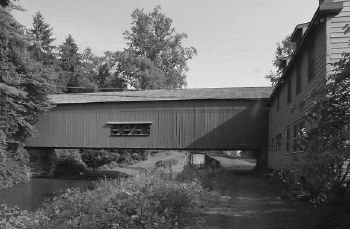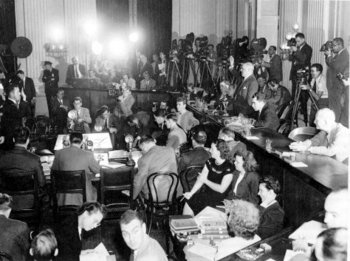An eye-catching title.
Newspapers have long known the selling power of the word "hoax" and correspondent Stuart Cummings Ripley was as savvy a newspaper contributor as there ever was. In late 1962 a disgruntled Ripley inserted this title above an opinion piece he'd submitted to a small newspaper in Bucks County, Pennsylvania. The piece recalled his time in front of the
House Committee on Un-American Activities (HUAC) and it shook the foundations of the United States federal government whose response was to smear and discredit the esteemed author into virtual obscurity. More importantly, however, the article's release kick-started the Feds' decision to systematically scrub the public record of Ripley's contributions to
literature, stage and screen.
 Ripley testifies before HUAC, 1952
Ripley testifies before HUAC, 1952Perhaps it was the vestiges of a prolonged depression and alcoholism over the suicide of his wife, the former Sally Beacon. Perhaps it was Ripley being playful with the HUAC, still in operation until the late sixties. Or perhaps Ripley had converted late in life from a literary curmudgeon to a humanitarian with a message. This had become the challenge, that of unraveling the literary gems that the enigmatic novelist, playwright and poet occasionally delivered to the news outlet he chose as his final pulpit, The Bucks County Repertoire, a small newspaper in operation in Bucks County, PA, from 1959 through 1967
"All of the above," was the conclusion of Jameson Illg, Op/Ed editor for The Repertoire, in one of his multiple articles on significant contributors the newspaper had the pleasure of publishing during its short history.
"The death of Ripley's wife Sally in 1938," Illg cited, "was always with him, having left so profound an influence that during his final days in Uhlerstown, PA, he decided to erect a small shrine to her. This was of course against the wishes of his long-time companion, the actress Jill Castenberry, but Ms. Castenberry relented, hoping the project would ease his guilt over Sally's death. Ripley soon announced it would be a shrine to all victims of suicide and looked for public funding to produce a more prominent tribute. It included sculpting her face into a ridge that overlooked the Delaware River, something with good visibility to the river's tourist traffic."
 Covered bridge, Uhlerstown, PA
Covered bridge, Uhlerstown, PAIllg's article recounted what eventually became known as Ripley's Uhlerstown Folly. "In the final stages of the project Ripley and his backers realized their error in judgment. The stone masons had polished the sculpture as far down as Sally's smile on a Friday then departed for the weekend. Monday morning four bodies were waiting for them, three in the brush sixty feet below on the bank of the Delaware and one a few hundred feet downstream. The authorities determined they were all suicides, concluding the victim in the river 'must have gotten a running start' before launching herself seat-first onto Sally's slippery forehead and down her nose. What took two months for the masons to carve into the face of the ridge took two days to destroy, done so under twenty-four security."
The Ruse behind the Hoax. Ripley's 1962 opinion piece in The Repertoire bitterly explained his actions before the HUAC: "Those monsters on the committee made it perfectly clear. I was either to produce the names of a few folks in the entertainment industry who had leftist leanings or pressure would be exerted on my closest friend Jill Castenberry to testify."
In one way it was his private joke, the piece maintained, the joke meant to show Ripley's contempt for the HUAC while at the same time protect Ms. Castenberry, who because of his cooperating testimony was dropped from the list of actor "friends" the Committee boasted were willing to appear voluntarily. The joke backfired arguably so loudly that the extended Hollywood and Washington repercussions turned into a firestorm. For this reason to this day what is left of the transcript of Ripley's appearances in front of the HUAC remains classified.
 Ripley (back turned) testifies before HUAC, 1952
Ripley (back turned) testifies before HUAC, 1952Ripley's account: "I did give that jackass committee the names of a few real-life Red sympathizers in the industry, folks already identified by prior witnesses, but the committee wasn't interested in simple validation. 'Tell us something we don't already know' was the message. So I also gave them some personages I conjured up before my third and final appearance at the hearings. I was in the middle of penning a new play and a number of wonderful names appeared on the pages in my typewriter. They were frauds of course, each one a hoax of a person, names of people I expected either did not exist or were of little political consequence if they did. One such name was a Norma J. Mortenson.
"How was I to know?" Ripley pleaded to the readership. "Tell me, just how was I to know those fools would go the lengths they did to legitimize my release from their hearings while they checked the names I'd supplied?"
It took until the famed Marilyn Monroe, baptized Norma Jeane Baker by her mother Gladys Baker but whose real birth name was Norma Jeane Mortenson, married Arthur Miller the playwright in 1956 (one such other "friendly witness" of the HUAC), for the committee to pounce on its prey. HUAC connected the misaligned dots all the way to the White House, whereupon Miller and Monroe divorced in 1961, Monroe died tragically and conveniently in 1962, and portions of the testimony of one Stuart Cummings Ripley were notably struck from the public record as the source of our federal government's interest in someone with "Communist leanings" who was also intimate with the President of the United States.
 Marilyn Monroe
Marilyn MonroeThe stage play Ripley referred to his The Repertoire piece, "My Front," had as its theme McCarthyism, blacklisting and the HUAC hearings. Ripley wrote it under the pseudonym Alexia Disse. Ripley used this pen name throughout the blacklist period, employing it with tongue in cheek as his own 'front' while quietly capitalizing on his unpublicized learning disability.
The play was performed in the mid-1950s off-Broadway by the East Side Experimental Theatre Company as a tribute to Ripley for earlier artistic contributions to the company's local notoriety. On the playbill were a number of pseudonymous blacklisted actors with conspicuous names (Herschie Barr, Nero Mustell, others) and the play said to have significantly influenced the Walter Bernstein screenplay for the 1976 Oscar-nominated movie The Front. Unfortunately Mr. Bernstein was never able to properly credit Ripley, the federal smear campaign successful in eliminating from the theater cognoscenti much of the stage work attributed both to Ripley and his pseudonym.
An appropriate curtain line for this journalistic offering should be the famous last lines from the original stage play as written by Stuart Cummings Ripley himself. First, the lines as performed on screen in one of the most outrageous climax scenes in Hollywood history when Howard Prince (Woody Allen) delivers this knockout punch in his final testimony to the HUAC:
"Fellas... I don't recognize the right of this committee to ask me these kinds of questions. And furthermore, you can all go fuck yourselves."
 Woody Allen, 1976
Woody Allen, 1976Perhaps Mr. Bernstein couldn't recall the exact dialogue from the stage play, or perhaps he did recall it and either censored himself or was censored by a homophobic Hollywood community, but the lines as written by Ripley read as follows:
"You want me to recognize the rights of this committee? Not a chance. And furthermore, you can all kiss the front of my pants. How about it? My front, or if you're so inclined, what's inside it? Your choice."
I feel I speak for scribes everywhere in offering the following sentiment: We've got your back as well as your front, Mr. Ripley. Well done, sir, with the expectation that some day you will receive your literary and patriotic due.
Knute Isinglass
Ohio Mercury Times Online
August 12, 2002
Reporter's note: Heavy contributions to this piece came from search engine NYSINYD.org (Now You See It, Now You Don't), an upstart and arguably rogue resource used worldwide by journalists for fact-checking. Availability is hit-or-miss as the engine occasionally drifts into federal computers and presents classified as well as declassified material. Enter keywords "Beware the Hoax in Progress" in quotes for an endless string of Ripley references.
_____________________________

